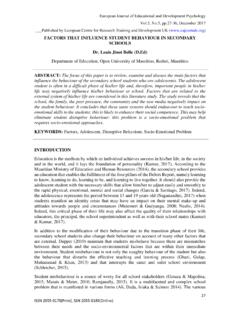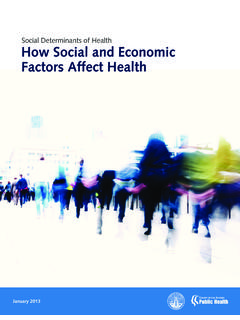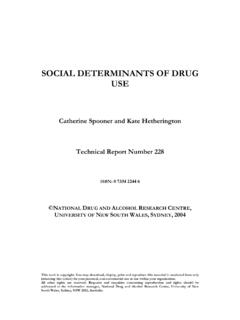Transcription of What are the main factors that influence the ...
1 What are the main factors that influence the implementation of disease prevention and health promotion programmes in children and adolescents? June 2005. ABSTRACT. This Health Evidence Network (HEN) report discusses the reasons for success or failure in implementing disease prevention or heatlth promotion programmes. Many of these programmes are directed at the health of children and young people because they can prevent both immediate problems (mortality and morbidity) and long-term problems. However, even where there is evidence to support such public health interventions, implementation in different settings and countries has met with varying degrees of effectiveness and sustainability.
2 The research evidence shows that the most effective programmes for children and young people are carried out at the government level, supported by society in general, and promote national policies to decrease poverty and increase social equality. HEN, initiated and coordinated by the WHO Regional Office for Europe, is an information service for public health and health care decision-makers in the WHO European Region. Other interested parties might also benefit from HEN. This HEN evidence report is a commissioned work and the contents are the responsibility of the authors.
3 They do not necessarily reflect the official policies of WHO/Europe. The reports were subjected to international review, managed by the HEN team. When referencing this report, please use the following attribution: Macfarlane A (2005). What are the main factors that influence the implementation of disease prevention and health promotion programmes in children and adolescents? Copenhagen, WHO Regional Office for Europe (Health Evidence Network report; , accessed [day month year]). Keywords HEALTH PROMOTION. HEALTH EDUCATION.
4 PRIMARY PREVENTION. ADOLESCENT HEALTH SERVICES. CHILD HEALTH SERVICES. PROGRAM EVALUATION. SOCIOECONOMIC factors . META-ANALYSIS. DECISION SUPPORT TECHNIQUES. EUROPE. Address requests about publications of the WHO Regional Office to: by e-mail (for copies of publications). (for permission to reproduce them). (for permission to translate them). by post Publications WHO Regional Office for Europe Scherfigsvej 8. DK-2100 Copenhagen , Denmark World Health Organization 2005. All rights reserved. The Regional Office for Europe of the World Health Organization welcomes requests for permission to reproduce or translate its publications, in part or in full.
5 The designations employed and the presentation of the material in this publication do not imply the expression of any opinion whatsoever on the part of the World Health Organization concerning the legal status of any country, territory, city or area or of its authorities, or concerning the delimitation of its frontiers or boundaries. Where the designation country or area appears in the headings of tables, it covers countries, territories, cities, or areas. Dotted lines on maps represent approximate border lines for which there may not yet be full agreement.
6 The mention of specific companies or of certain manufacturers' products does not imply that they are endorsed or recommended by the World Health Organization in preference to others of a similar nature that are not mentioned. Errors and omissions excepted, the names of proprietary products are distinguished by initial capital letters. The World Health Organization does not warrant that the information contained in this publication is complete and correct and shall not be liable for any damages incurred as a result of its use.
7 The views expressed by authors or editors do not necessarily represent the decisions or the stated policy of the World Health Organization. 2. What are the main factors that influence the implementation of disease prevention and health promotion programmes in children and adolescents? WHO Regional Office for Europe's Health Evidence Network (HEN). June 2005. Summary .. 4. The 4. 4. Policy 4. Type of evidence .. 4. Introduction .. 6. Sources for this 7. 7. Examples of public health interventions that show evidence of effectiveness.
8 7. Interventions where there are gaps in evidence or conflicting evidence of effectiveness .. 8. Discussion of factors that influence the success and failure of public health programmes .. 9. Required 13. Current debate .. 13. Discussion .. 14. Summary of 14. Strength of evidence of 14. Generalizability of 14. Policy 15. Conclusions .. 15. References .. 16. 3. What are the main factors that influence the implementation of disease prevention and health promotion programmes in children and adolescents? WHO Regional Office for Europe's Health Evidence Network (HEN).
9 June 2005. Summary The issue Many disease prevention and health promotion programmes are directed at the health of children and young people because they can prevent both immediate problems (mortality and morbidity) and long- term problems. However, even where there is evidence to support such public health interventions, implementation in different settings and countries has met with varying degrees of effectiveness and sustainability. The issues addressed in this synthesis concern the main reasons for the success or failure of such programmes in Europe.
10 Findings Evidence exists to support use of the following disease prevention and health promotion interventions: immunization programmes;. folic acid supplementation during pregnancy;. promotion of breast feeding;. prevention of sudden infant death syndrome;. promotion of use of cycle helmets, child restraints, etc.;. smoking cessation aids;. screening for post-natal depression; and psychosocial interventions for those at high risk of mental health problems. The factors that affect the successful implementation of such programs are: national planning, political factors and capacity.


















